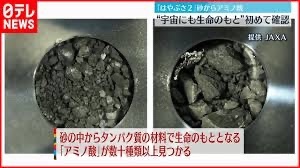
Hayabusa2: 砂から20種以上のアミノ酸:
20 sortes d’acides aminés du sable :
20 Arten von Aminosäuren aus Sand:
20 kinds of amino acids from sand:
來自沙子的20多種氨基酸:
ー生命の起源の謎に迫るー
JAXA
昨年6月、世界各国の研究機関に砂を配布した。
本格的な分析を始めると発表。
初期分析の段階:
すでに、
「炭素や窒素など有機物が含まれていること」は分かっている。
「たんぱく質の材料になるアミノ酸があるかどうか」が注目されていた。
アミノ酸の存在:
ヒトの体内のたんぱく質を形作るアミノ酸は20種類。
そのうち、「体内でつくることのできないイソロイシンやバリンなど」を確認。
- コラーゲンの材料になるグリシンのほか、
- うまみ成分として知られるグルタミン酸も、
「はやぶさ2」の砂から見つかった。
近く論文が公開:
アミノ酸を地球以外で確認するのは初めて。
生命の起源の謎に迫る研究成果で、近く論文で公開される見通しだ。
朝日新聞デジタル
https://www.asahi.com/articles/ASQ6572ZQQ65TIPE002.html
Hayabusa2 : Plus de 20 sortes d’acides aminés du sable :
-Aborder le mystère de l’origine de la vie-
JAXA
En juin dernier, nous avons distribué du sable aux instituts de recherche du monde entier.
Annoncé pour commencer l’analyse à grande échelle.
Phase d’analyse initiale :
déjà,
On sait qu'”il contient des substances organiques telles que le carbone et l’azote”.
L’attention a été portée sur “s’il existe des acides aminés qui peuvent être utilisés comme matériaux protéiques”.
Présence d’acides aminés :
Il existe 20 types d’acides aminés qui forment des protéines dans le corps humain.
Parmi eux, “l’isoleucine, la valine, etc. qui ne peuvent pas être fabriquées par l’organisme” ont été confirmées.
En plus de la glycine, qui est un matériau pour le collagène,
L’acide glutamique, qui est connu comme un ingrédient umami,
Trouvé dans le sable de “Hayabusa2”.
L’article sera bientôt publié :
C’est la première fois pour confirmer les acides aminés en dehors de la terre.
Il s’agit d’un résultat de recherche qui aborde le mystère de l’origine de la vie et qui devrait être publié prochainement dans un article.
Asahi Shimbun Numérique
Hayabusa2: Mehr als 20 Arten von Aminosäuren aus Sand:
-Annäherung an das Mysterium des Ursprungs des Lebens-
JAXA
Im vergangenen Juni haben wir Sand an Forschungsinstitute auf der ganzen Welt verteilt.
Angekündigt, mit einer umfassenden Analyse zu beginnen.
Erste Analysephase:
schon,
Es ist bekannt, dass “es organische Substanzen wie Kohlenstoff und Stickstoff enthält”.
Es wurde darauf geachtet, “ob es Aminosäuren gibt, die als Proteinmaterialien verwendet werden können”.
Vorhandensein von Aminosäuren:
Es gibt 20 Arten von Aminosäuren, die im menschlichen Körper Proteine bilden.
Darunter wurden „Isoleucin, Valin usw., die nicht im Körper hergestellt werden können“ bestätigt.
Neben Glycin, das ein Material für Kollagen ist,
Glutaminsäure, die als Umami-Inhaltsstoff bekannt ist,
Gefunden im Sand von “Hayabusa2”.
Papier wird in Kürze veröffentlicht:
Dies ist das erste Mal, dass Aminosäuren außerhalb der Erde bestätigt werden.
Es ist ein Forschungsergebnis, das sich dem Mysterium der Entstehung des Lebens nähert und in Kürze in einem Paper veröffentlicht werden soll.
Asahi Shimbun Digital
More than 20 amino acids found in samples from Ryugu asteroid
NHK WORLD-JAPAN News
Japan’s science ministry
says more than 20 types of amino acid have been found in samples collected from the Ryugu asteroid.
The discovery may help scientists
better understand the origins of life, as amino acids are one of its basic building blocks.
The sand and dust samples
were collected from the asteroid and brought to Earth by Japan’s Hayabusa2 space probe in 2020.
Eight teams in the country,
including one at the Japan Aerospace Exploration Agency, have been analyzing the materials.
Amino acids are an essential substance in most forms of life and are thought to have existed since shortly after the Earth was formed.
One theory suggests that
they ceased to exist on Earth during a period when the planet became extremely hot but were reintroduced from outer space by meteors.
The ministry says the eight teams are wrapping up their analyses, and detailed data are expected to be made public in academic papers and other publications.